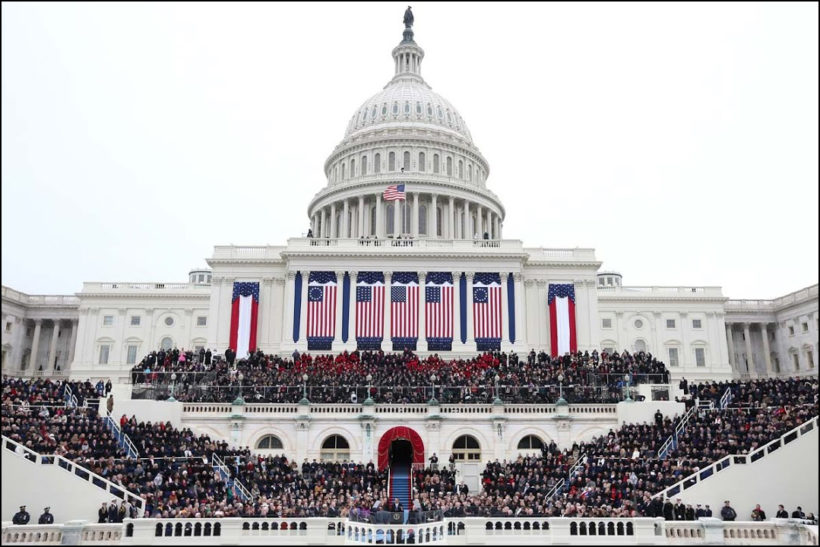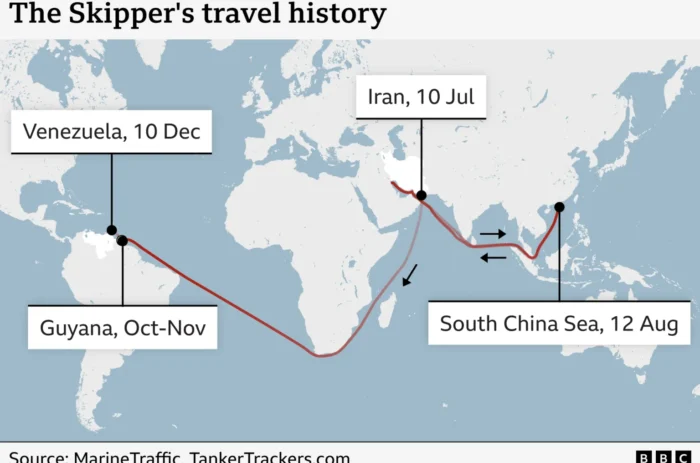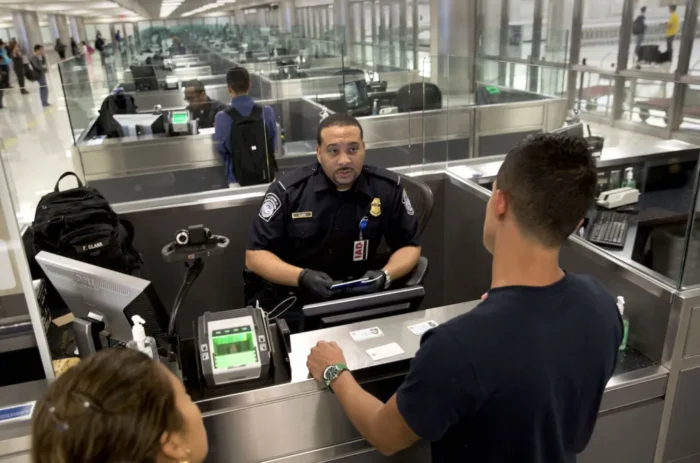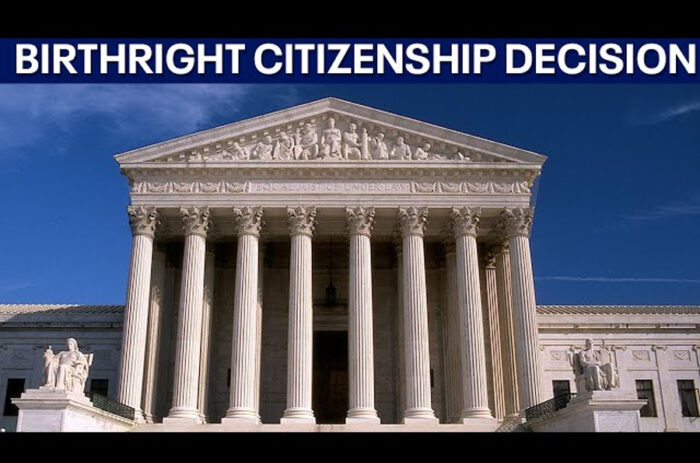
redo Jump to...
print Print...
(by Zach Montellaro, Politico) –
When is the inauguration?
Donald Trump will be inaugurated as the 45th president of the United States on January 20. The ceremony is scheduled to start at 11:30 a.m., with a musical prelude beforehand. Afterward, President Donald Trump and Vice President Mike Pence are slated to participate in the traditional inaugural parade, which is scheduled to start at 3 p.m.
Where can I watch the inauguration?
If you’re in Washington D.C., there is both ticketed and non-ticketed viewing locations for the ceremony. Security gates will open at 6 a.m. Tickets were distributed by members of Congress and the inaugural committee. If you’re not in Washington, major broadcast and cable networks will show the ceremony, and [most news organizations should] stream the ceremony.
The parade route will follow Pennsylvania Avenue between the Capitol to the White House, and much of it will be open to the public and unticketed. It will pass right past Donald Trump’s hotel in the Old Post Office.
Who is going to be at the inauguration?
Besides Trump, his family and the Obamas, several living ex-presidents will be in attendance. Jimmy Carter was the first to say he will attend, and so will George W. Bush. Former Vice President Dick Cheney also said he will be there. Both former President Bill Clinton and 2016 presidential election nominee Hillary Clinton are also slated to attend. A George H. W. Bush spokesman said he will not be there, citing health concerns.
Prominent faith leaders like Catholic Cardinal Timothy Dolan and the Reverend Franklin Graham will also be there.
Donald Trump encouraged his supporters to set an “all time record” for attendance, but planners are expecting about 800,000 people, well below President Obama’s first inaugural.
What’s the order of the ceremony at inauguration?
The ceremony opens with the call to order from Sen. Roy Blunt, followed by readings and invocations and music from the Missouri State University chorale. Mike Pence will then take the Vice Presidential oath of office, administered by Supreme Court Justice Clarence Thomas. The Mormon Tabernacle Choir performs, and then Donald Trump takes the presidential oath of office, administered by Supreme Court Chief Justice John Roberts.
Trump will give his inaugural address, followed by more readings and a benediction and close with the national anthem. The complete program is here.
What should we expect for Trump’s inauguration speech?
Donald Trump tapped Stephen Miller to pen his much-anticipated speech. Miller frequently served as the warm-up act on the campaign trail for Trump. Early discussions of the speech focused on structural problems within the country and setting an agenda for Trump’s first 100 days and beyond. (read the address at whitehouse.gov/inaugural-address)
What about the parade?
The inaugural committee announced the parade lineup in late December, which includes high school bands, police troops and civic groups found across the country. The statement also said that all branches of the military will be represented.
A minor controversy broke out over the parade’s announcer. Charlie Brotman, an 89-year-old who has announced every inaugural parade since President Dwight D. Eisenhower’s second term, was replaced by Trump’s inaugural committee. Brotman is instead “Announcer Chairmen Emeritus.”
What is the rest of the inauguration weekend schedule?
The inauguration festivities are not confined to just the day-of events. Trump and Pence attended a wreath laying ceremony at Arlington National Ceremony on January 19 and then hosted a “Make America Great Again! Welcome Celebration” at the Lincoln Memorial that evening, which was open to the public. After his inauguration, Trump will attend inaugural balls that evening — but only three, a sharp decline when compared to President Obama in 2009.
“We’ll have basically three balls. Two in the [Washington] Convention Center, one called the Commander in Chief ball, which is a traditional military ball. And then we’ll have a series of private dinners.”
The new president will also attend a national prayer service at Washington National Cathedral on January 21.
There’s also plenty of unofficial events taking place. Three separate pro-Trump biker groups are organizing rallies honoring the new president, and there’s a litany of unofficial inaugural balls.
The weekend is also expected to draw a lot of anti-Trump protests. The largest is expected to be the Women’s March on Washington. Organizers of the march predicted 200,000 people will attend in a permit application. Other rallies, both pro and anti-Trump, predict anywhere from 100 to 50,000 attendees.
What will President Obama do at inauguration?
President Obama and Donald Trump will meet at the White House prior to the latter’s inauguration. The pair will ride with their wives to the inauguration from the White House. After the inauguration, Obama and his family will take one final flight on Air Force One to an as-of-yet-announced destination, which is customary. …
Reprinted here for educational purposes only. May not be reproduced on other websites without permission from Politico.
Questions
1. What number president will Donald Trump be?
2. What time does the presidential inauguration ceremony begin?
3. What time is the traditional inaugural parade?
4. Who can attend the inaugural parade?
5. While the Supreme Court’s chief justice always swears in the president-elect on the inauguration stage, it’s common for one of the other justices to do so for the vice president. Which justice has vice-president-elect Mike Pence asked to administer his oath of office?
6. List the 9 events that take place on Inauguration Day.
7. Read the Background and Resources below the questions. Which fact most surprises you about past presidential inaugurations? Explain your answer.
CHALLENGE: Watch President Trump’s inaugural address and answer the following: (text at whitehouse.gov/inaugural-address)
- Tone is the attitude a speaker takes: What tone did Donald Trump take in his inauguration speech on Friday, Jan. 20? What was the tone of the address? (optimistic, hopeful, enthusiastic, solemn, inspiring, negative, complaining? …)
- How long was President Trump’s speech?
- What was the main focus of President Trump’s speech?
- What inspired you the most about President Trump’s address? (If it did not inspire you at all, why not?)
Scroll down to the bottom of the page for the answers.
Background
Nine events take place every Inauguration Day. (Read about the nine events at inaugural.senate.gov.). Events include:
- Morning Worship Service
- Procession to the Capitol
- Vice President’s Swearing-In Ceremony
- President’s Swearing-In Ceremony
- Inaugural Address
- Departure of the Outgoing President
- Inaugural Luncheon
- Inaugural Parade
- Inaugural Ball
10 Interesting Things You Should Know About Inauguration Day: (from about.com)
1. Shortest Inaugural Address George Washington gave the shortest inauguration address in history during his second inauguration on March 4, 1793. Washington’s second inaugural address was only 135 words long! The second shortest inaugural address was given by Franklin D. Roosevelt at his fourth inauguration and was only 558 words long.
2. Inauguration Blamed for President’s Death Even though there was a snowstorm on William Henry Harrison’s inauguration day (March 4, 1841), Harrison refused to move his ceremony indoors. Wanting to prove that he was still a hardy general who could brave the elements, Harrison took the oath of office as well as delivered the longest inaugural address in history (8,445 words, which took him nearly two hours to read) outside. Harrison also wore no overcoat, scarf, or hat.Shortly after his inauguration, William Henry Harrison came down with a cold, which quickly transformed into pneumonia. On April 4, 1841, having only served 31 days in office, President William Henry Harrison died. He was the first President to die in office and still holds the record for serving the shortest term.
3. Sundays Inaugurations are never held on Sundays. If January 20 falls on a Sunday, the oath is then given privately on Saturday or on Sunday and then the public inauguration day celebrations are held on Monday with the oath repeated. [The Constitution requires presidential terms to begin on Jan. 20.]
4. Few Constitutional Requirements It is a bit surprising how little the Constitution prescribes for inauguration day. In addition to the date and time, the Constitution only specifies the exact wording of the oath taken by the President-elect before he begins his duties. The oath states: “I do solemnly swear (or affirm) that I will faithfully execute the Office of President of the United States, and will to the best of my ability, preserve, protect and defend the Constitution of the United States.” (Article II, Section 1 of the U.S. Constitution)
5. So Help Me God Although not officially part of the official oath, George Washington is credited with adding this line after he finished the oath during his first inauguration. Most Presidents have also uttered this phrase at the end of their oaths. Theodore Roosevelt, however, decided to end his oath with the phrase, “And thus I swear.”
6. An Embarrassing Vice President In the past, the Vice President took his oath of office in the Senate Chamber, but the ceremony now occurs on the same platform as the President’s swearing-in ceremony on the west front terrace of the Capitol. The Vice President takes his oath and gives a short speech, followed by the President. This usually goes very smoothly, except for in 1865.Vice President Andrew Johnson hadn’t been feeling very well for several weeks before inauguration day. To get him through the important day, Johnson drank a few glasses of whiskey. When he got up to the podium to take his oath, it was obvious to everyone that he was drunk. His speech was incoherent and rambling and he didn’t step down from the podium until someone finally pulled on his coattails.
7. The Oath Givers Although it is not stipulated in the Constitution, it has become a tradition to have the Chief Justice of the Supreme Court be the oath giver to the President on inauguration day. This, surprisingly, is one of the few traditions of inauguration day not begun by George Washington, who had the Chancellor of New York Robert Livingston give him his oath (Washington was sworn in at Federal Hall in New York). John Adams was the first President to have a Chief Justice of the Supreme Court swear him in.Chief Justice John Marshall, having given the oath nine times, holds the record for having given the most presidential oaths on inauguration day. The only President to become an oath giver himself was William H. Taft, who had become a Chief Justice of the Supreme Court after he had served as President. The only woman to have ever sworn in a President was U.S. District Judge Sarah T. Hughes, who swore in Lyndon B. Johnson on board Air Force One.
8. Traveling Together In 1837, outgoing President Andrew Jackson and President-elect Martin Van Buren rode together to the Capitol on inauguration day in the same carriage. Most of the following Presidents and President-elects have continued this tradition of traveling together to the ceremony. In 1877, the inauguration of Rutherford B. Hayes began the tradition of the President-elect first meeting the outgoing President at the White House for a short meeting and then traveling from the White House together to the Capitol for the ceremony.
9. The Bible The tradition of the President taking his oath of office with his hand on a Bible was first begun by George Washington during his first inauguration. Some Presidents have opened the Bible to a random page (like George Washington in 1789 and Abraham Lincoln in 1861) while most others have opened the Bible to a specific page because of a meaningful verse. Of course, there is always the option to keep the Bible closed like Harry Truman did in 1945 and John F. Kennedy in 1961. Some Presidents even had two Bibles (with either both opened to the same verse or two different verses), while only one President refrained from using a Bible at all (Theodore Roosevelt in 1901).
10. The Lame Duck Amendment Back in a time when news was carried by messengers on horses, there needed to be a great length of time between Election Day and inauguration day so that all the votes could be tallied and reported. To allow this time, inauguration day used to be March 4.By the early twentieth century, this huge amount of time was no longer needed. The inventions of the telegraph, the telephone, automobiles, and airplanes had greatly cut the reporting time needed. Rather than make the lame duck President wait for four whole months to leave office, the date of inauguration day was changed in 1933 to January 20 by the addition of the 20th Amendment to the U.S. Constitution. The Amendment also specified that the exchange of power from the lame duck President to the new President would take place at noon. Franklin D. Roosevelt was both the last President to be inaugurated on March 4 (1933) and the first President to be inaugurated on January 20 (1937).
Resources
Watch the 2017 Inauguration events at: c-span.org/2017
The complete program for the Inauguration is at: inaugural.senate.gov.
Presidential Inauguration Quiz:
1. In which city did the first inauguration take place?
a) Philadelphia
b) Richmond, Va.
c) New York City
2. Which president gave the longest Inaugural Address?
a) Bill Clinton
b) George Washington
c) William Henry Harrison
3. Who was the only president to take the oath of office from a woman?
a) Lyndon B. Johnson
b) George H. W. Bush
c) Ronald Reagan
4. African-American soldiers first marched in whose inauguration parade?
a) Ulysses S. Grant’s
b) Theodore Roosevelt’s
c) Abraham Lincoln’s
5. Which chief justice administered the most presidential oaths?
a) John Jay
b) Earl Warren
c) John Marshall
6. Inauguration Day was officially changed from March 4 to Jan. 20 thanks to the passage of the 20th Amendment in 1933. Why?
a) Congress did not want the inauguration to fall during Lent.
b) It often rained on March 4.
c) The transition period between the election and the inauguration of the president-elect was deemed too long.
7. Which president tossed the Super Bowl coin the same day as his swearing-in?
a) Richard Nixon
b) Gerald Ford
c) Ronald Reagan
8. Which president administered the oath of office to two of his successors?
a) William Howard Taft
b) George Washington
c) John Quincy Adams
9. Who was sworn in on a Bible written in a modern foreign language?
a) Thomas Jefferson
b) Franklin D. Roosevelt
c) John F. Kennedy
10. Which president was given the oath of office by his own father?
a) John Quincy Adams
b) Calvin Coolidge
c) George W. Bush
(Quiz posted at Parade Magazine on Jan. 20, 2013, by Kenneth C. Davis, author of “Don’t Know Much About the American Presidents” and “Don’t Know Much About History.”)
Scroll down to bottom of page for answers.
Daily “Answers” emails are provided for Daily News Articles, Tuesday’s World Events and Friday’s News Quiz.
Answers
ANSWERS TO PRESIDENTIAL INAUGURATION QUIZ FOUND UNDER “RESOURCES”:
1. c) New York City was the temporary capital of the United States when Washington took the oath on April 30, 1789.
2. c) Harrison’s speech in 1841 was more than 8,000 words long and took nearly two hours to deliver on a cold, windy day. He fell ill with pneumonia and died one month later. (The shortest Inaugural Address – just 135 words long – was Washington’s second.)
3. a) After the assassination of John F. Kennedy, Johnson was sworn in aboard Air Force One by Sarah T. Hughes, a U.S. district judge.
4. c) At Lincoln’s second inauguration, in 1865, four companies of African-American troops and lodges of African-American Masons and African-American Odd Fellows joined the procession to the Capitol.
5. b) Marshall administered the oath nine times, from Thomas Jefferson’s first inauguration, in 1801, to Andrew Jackson’s second, in 1833.
6. c) The old March 4 inaugural date had been selected when travel and communications were much slower, and the “lame duck” period for the outgoing president rarely caused problems. But the long transition became an issue in 1932 during the Great Depression, because it meant that the next president would be unable to act until four months after his election. The 20th Amendment, first proposed in March of that year, changed the date but didn’t go into effect in time for Franklin D. Roosevelt’s first term. In 1937, he became the first president inaugurated under the new rule.
7. c) On Jan. 20, 1985, Reagan took the oath privately in the Entrance Hall at the White House, and later went to the Map Room to flip the coin on live television via satellite. (The 49ers won the toss, and the game.)
8. a) William Howard Taft Taft was appointed chief justice in 1921 – eight years after his presidency – and administered the oath of office to both Coolidge (in 1925) and Hoover (in 1929).
9. b) Roosevelt used an old family Bible written in Dutch at all four of his inaugurations.
10. b) Coolidge was sworn in by his father, a justice of the peace, at the Coolidge family homestead in rural Vermont on Aug. 3, 1923, after he was informed that President Harding had passed away.



